How many miles does the Daytona 500 have? Here's everything you need to know
"Drivers, start your engines!"
That's what Dwayne "The Rock" Johnson will yell, weather permitting, at a long line of race cars Sunday afternoon in front of 150,000 people. DJ Khaled will drop the green flag (or he would have if not for the rain postponement), the engines will roar, and the 66th annual Daytona 500 will begin.
But if you're not a race fan, and statistically some of you probably aren't, you may not understand why your friends, family and coworkers are wearing hats with numbers on them or why Publix is out of beer.
If you just want to know what's going on or want to keep up with the conversations, read on.
Daytona 500 updates: Follow along for the latest from the Great American Race
What is the Daytona 500?
The Daytona 500, the Great American Race, is the biggest event in NASCAR, the stock car race that kicks off the new NASCAR Cup Series every year. It's huge, it's important, it's exciting, it brings in celebrities, and yes, it's a little weird for a sport to have its most important event at the beginning of the season but, as you'll hear fans say a lot, "That's racin'."
NASCAR Cup Series drivers want a Daytona 500 win more than anything. It has the biggest purse of any NASCAR race but more than that, it's the prestige. It's the Super Bowl ring, the Masters green jacket, the Olympic medal. Even presidents have shown up to watch the race. In 2023, an average of 8.17 million people tuned in to watch, peaking at 10.1 million viewers, according to BlackBook Motorsport. From 1995 to 2020, television ratings in the U.S. for the Daytona 500 were higher than any other auto race.
Fans see it as a full-day destination holiday. There's the race, sure, but there are also hours of analysis and predictions and driver interviews, and at the track there are fan activities and a prerace concert by Grammy-winning superstar Pitbull. (And, this year, Floridians can also bet on the Daytona 500.)
Racer car, time trial and stunt drivers had been tearing up the sand at Daytona Beach for 50 years when NASCAR founder Bill France decided to move them into a track with high banks so the cars could go faster. He and some backers built the Daytona International Speedway, opened it in 1959 and the 500 was born.
What is the Daytona 500 start time? Where is it held?
The Daytona 500 is on a Sunday in February at the Daytona International Speedway in Daytona Beach, Florida.
The 2024 Daytona 500 was set to begin Sunday, Feb. 18 at 2:30 p.m. ET, but rain pushed the race back to Monday. It got underway about 4:30 p.m. ET Feb. 19.
How can I get Daytona 500 tickets?
Good luck. The Daytona 500 sold out last November, the fastest it's sold out in the modern era of NASCAR. Your best bet now is shelling out big bucks for tickets from a reseller. But you can watch it at home, someone else's home, or your neighborhood sports bar.
How can I watch the Daytona 500 and what TV channel is it on? Is the Daytona 500 streaming?
The race will be broadcast on Fox and streamed on FoxSports.com and the Fox Sports app (TV provider log-in required), fuboTV (7-day free trial), YouTube TV (2-week free trial), Hulu + Live TV
If you just want to listen, you can follow along on SiriusXM NASCAR (Ch. 90) or the Motor Racing Network.
What is Speedweek?
Speedweek is like if there were a series of big football games, a college game, and a soccer game thrown in during the days before the Super Bowl.
In the week before the Daytona 500, there's a Cup Series qualifying race, two Daytona 500 qualifying races, a truck race, an ARCA race (the Automobile Racing Club of America, a semi-professional league), and then the actual Daytona 500. You can find the schedule here.
What does the 500 mean in the Daytona 500? Are there 500 laps?
The track at Daytona International Speedway is 2.5 miles. To win the Daytona 500, a driver must be the first one to finish 200 laps, which would be 500 miles. See? Easy.
How long does the Daytona 500 last?
Usually, between three and four hours if all goes well and there are no major multi-car wrecks or adverse track conditions and it doesn't rain.
What happens if the Daytona 500 gets rained out?
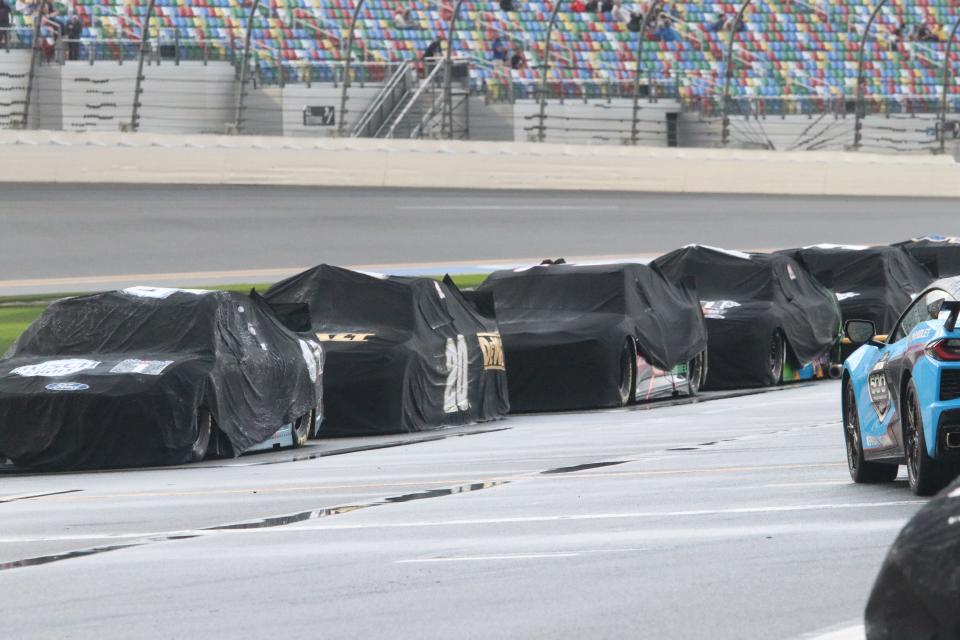
Everything stops.
The cars pull over to the side and get covered up. Teams can't work on them. Fans huddle under ponchos and overhangs. Drivers post selfies or go on a fast food run. 150,000 people keep refreshing their weather apps and everyone just waits for the rain to pass.
Then, and even sometimes while light rain is still falling, the fleet of Air Titans hit the track to dry it out. The Air Titans are big vacuum/sweeper trucks equipped with compressed air to blow water off the track and suck it up. Once the track is deemed safe enough to drive on, the race continues.
What is the Daytona 500 weather forecast?
It'll rain, we just don't know how much or for how long.
So far there's a 70-90% chance of rain on Saturday night and Sunday morning in Daytona Beach, according to meteorologists at the National Weather Service in Melbourne. Scattered showers are expected all day Sunday but the chance for showers Sunday evening has been dropping through the week and is now down to 40%.
How long will the Daytona 500 wait for rain?
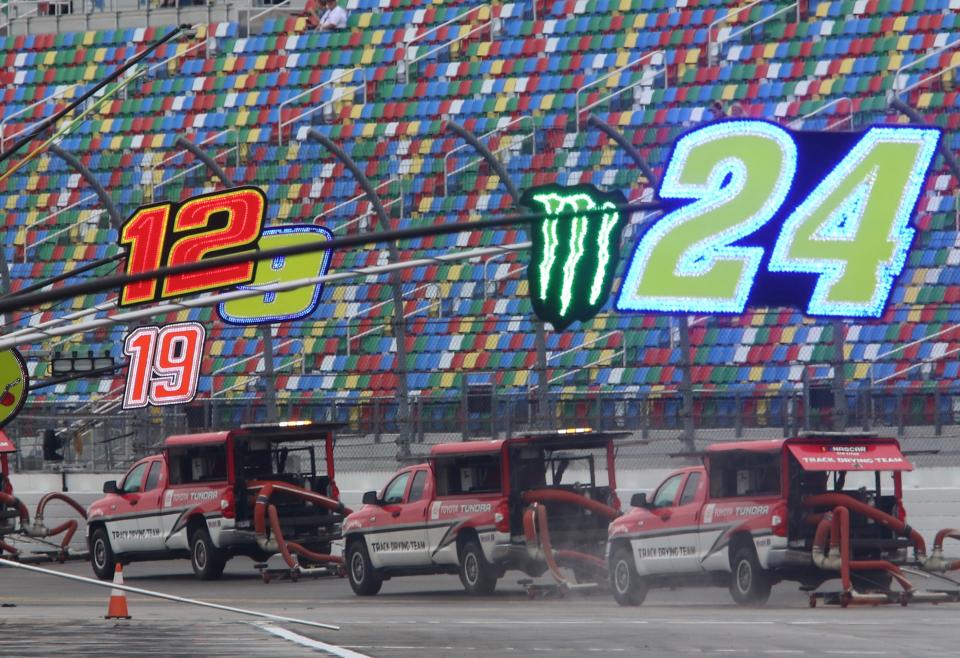
There are three stages during the Daytona 500 when drivers in the lead can earn points. The first two stages are 65 laps each and the final one is 70.
If the rain just won't stop and officials call it, the driver in the lead after at least 100 laps or the end of Stage 2, whichever comes first, will be declared the winner.
NASCAR and speedway officials don't want to do this, of course, and they will try very hard to run the complete race. Winning due to rain isn't terribly satisfying to the driver, the team, the speedway or the fans. In previous years the race has been delayed and restarted well into the night and the next morning to get a winner, or postponed to later on Monday.
How many cars start in the Daytona 500? What is the Daytona 500 qualifying order?
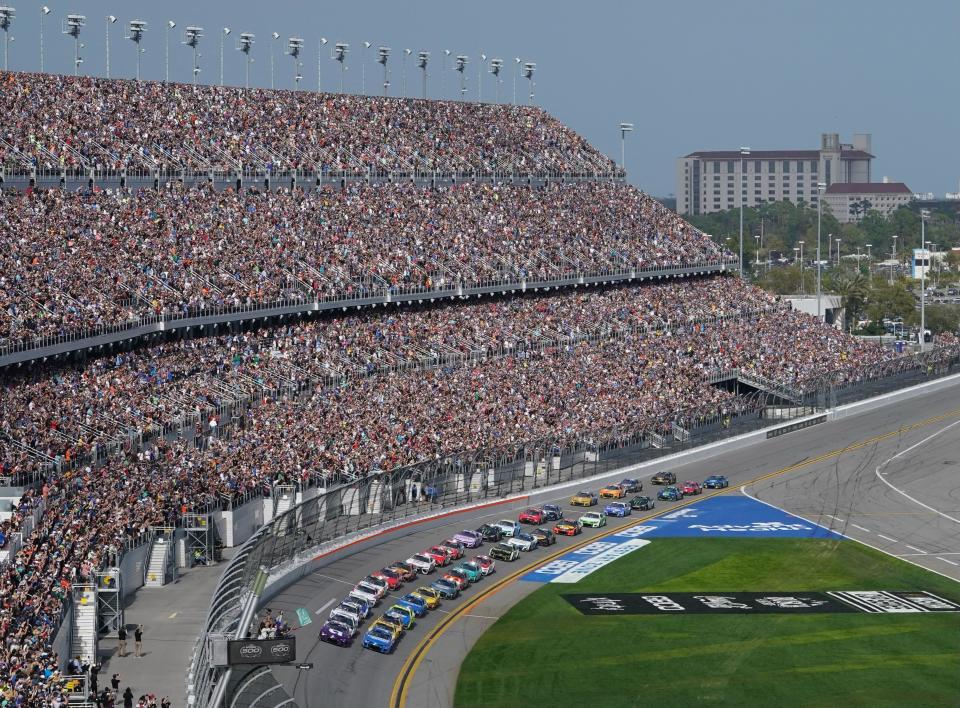
There are 40 drivers in the 2024 Daytona 500. But there are 42 drivers this year trying to get in.
Of the 40 spots, 36 are reserved for drivers from teams that own charters (sort of like franchises), which leaves four spots open for anyone. Drivers compete in two qualifying races in the week leading up to the big race to see who makes it in and where they'll be in the pack when the green flag flies.
First, drivers take one lap around the track in the Daytona 500 qualifying. The two fastest cars get locked into positions one and two in the starting lineup of the final race. That's the pole position, and they're called pole-sitters. The driver speeds in this qualifying event determine the lineup for the twin qualifying races the next day. The two fastest non-chartered drivers get two of the open spots.
This year Joey Logano, in the No. 22 Team Penske Ford, turned a lap in 49.465 seconds for an average speed of 181.947 mph to win the pole position and get the No. 1 spot in the race Sunday. Second spot by less than a tenth of a second was Michael McDowell, who averaged 181.686 in his No. 34 Ford from Front Row Motorsports.
In the twin qualifying races — called the Duels, and currently known as the Bluegreen Vacations Duel races — the drivers are split into two races of 150 miles each and their success here determines their position in the starting grid of the Daytona 500 on Sunday. The two fastest non-chartered drivers in these races get the last two open spots.
Start your engine: 10 tips on how to become a NASCAR driver
How fast do cars go in the Daytona 500? What's the maximum speed?
The fastest time in NASCAR history that anyone had a clock on was 212.089 mph by Bill Elliott during a qualifying run at Talladega Superspeedway. It's a record that's likely to remain unbeaten because in 1987, after some truly spectacular wrecks and a fatality, NASCAR started mandating restrictor plates on all cars and made other changes since to force everyone to slow down.
Just curious: How fast could you drive the Daytona 500 if there were no rules? 'What If' video goes to extremes
Why are the Thunderbirds at the Daytona 500?
At the end of the national anthem, the U.S. Air Force Thunderbirds will perform their signature “Delta” formation over the Speedway just before the green flag drops for the start of the Daytona 500. This will be their 14th consecutive year soaring over the track.
“The Thunderbirds recently celebrated 70 years of excellence,” said Thunderbird #1, Lt. Col. Nathan Malafa. “Since our inception, the Thunderbirds have become a unifying force, focused on inspiring America and communities across the world to pursue perfection and capture excellence.”
The squadron is composed of 12 officers and more than 120 enlisted personnel from across nearly 30 Air Force job specialties.
What's bump drafting? What's a pace car? When does a caution flag fly?
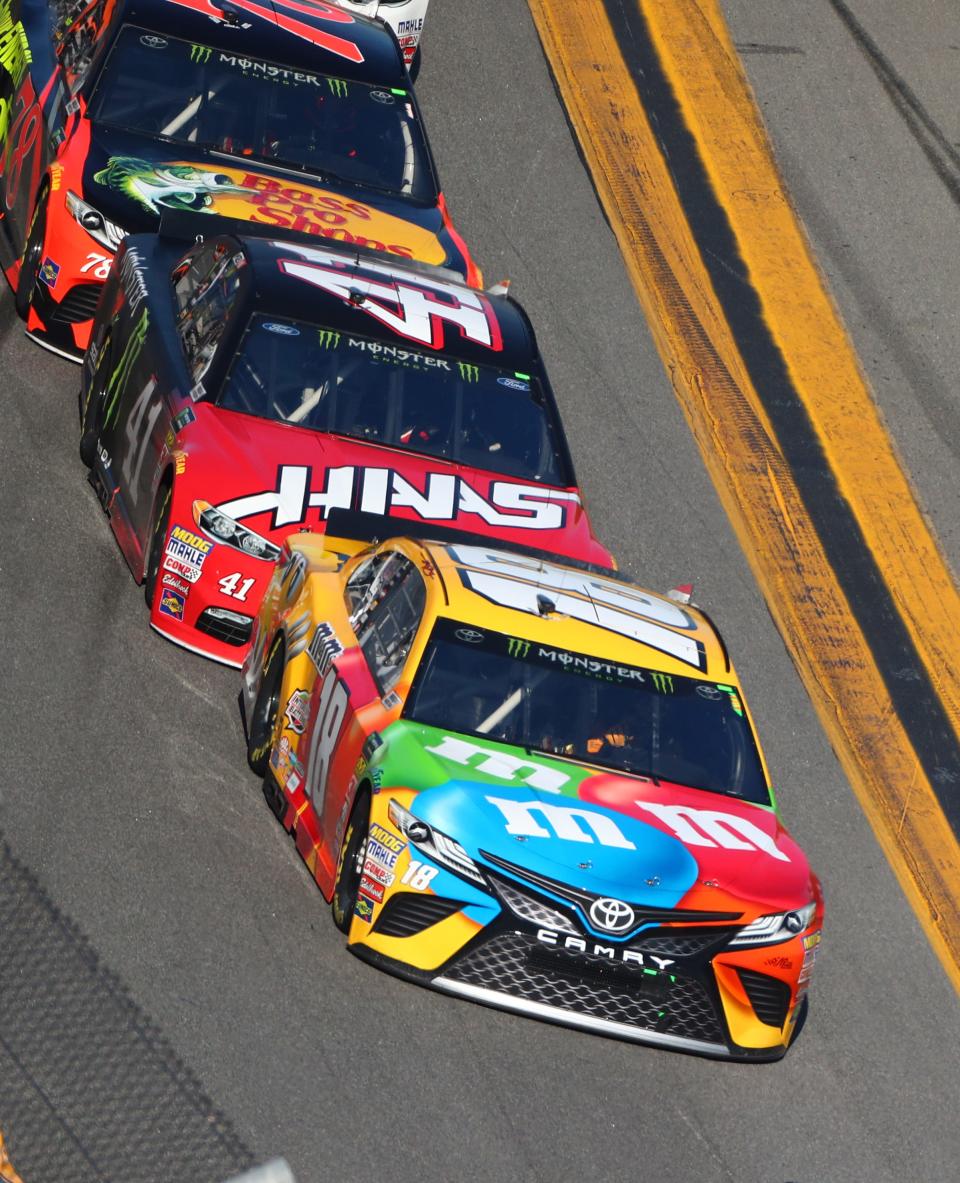
A quick guide to some basic racing terminology:
The field: The cars on the track. "The field is approaching the green flag."
Pace car: This is a car that comes out and leads the field around the track during caution stops and restarts to maintain an even speed. Like being stuck behind a student driver.
Green flag: This is waved to start the race.
Caution flag: This yellow flag is waved when there's a hazardous situation on the track. The pace car comes out in front of the field and keeps a steady 70 mph speed to slow them down while the problem is resolved.
Green-white-checker flag: This gets waved when the race only has two more laps to go but there's a caution flag. It means the race will be extended two more laps.
Checkered flag: This is waved when the winner crosses the start/finish line.
Drafting: Now we need to get into the aerodynamics of the thing. When two cars are driving one after the other, almost touching, they're drafting. The first car is punching a hole in the air and creating a bubble or vacuum behind it. The second car, slipping into that bubble, gets much less air resistance and can go faster. What's a bit mind-blowing is that when this happens, the air now flowing over both cars gives the driver in front a little boost, too, so two cars driving closely together can go faster than one car alone. Often used by teammates to help each other out.
Restrictor plate: A device installed on the intake of an engine to limit how much power it has. Restrictor plates limit a car's speed and were mandated by NASCAR after increasingly fast cars led to increasing bad wrecks.
Bump drafting: Like drafting, but weaponized. If you're trying to pass someone you can slip into that air bubble behind their car and then "bump" or push the car in front. That raises the rear of their car and when it comes back down the car can lose traction and the driver may have to correct, which gives you a chance to get around them. Bump drafting was banned in NASCAR races in 2014.
What does the winner win in the Daytona 500?
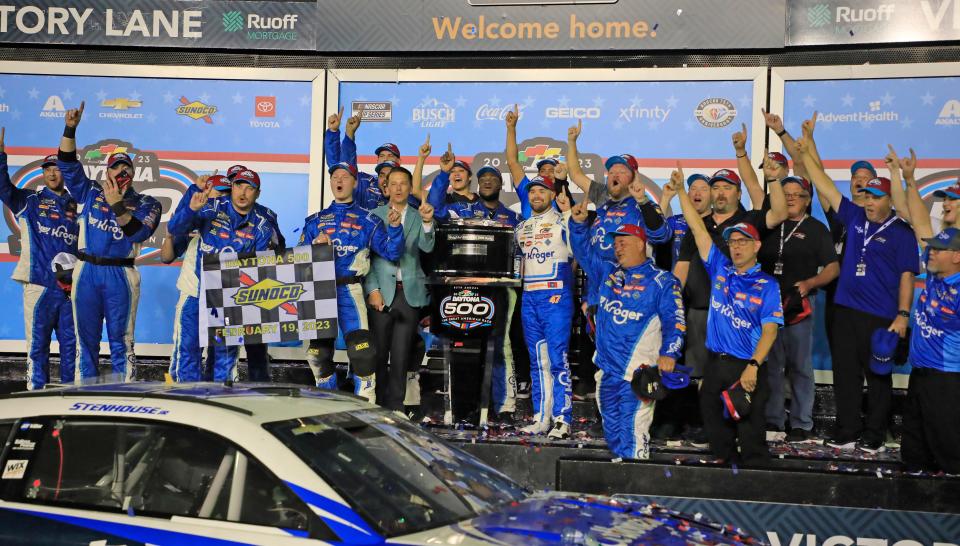
Lifetime bragging rights, a bunch of money, and their name on a really big trophy.
The total purse — all the money available to win — for the 2024 Daytona 500 is a record-breaking $28,035,991. But as of 2016 NASCAR doesn't reveal how much of that the winner actually wins and how much goes to other drivers.
In 2015, it came out to about 9% of the total so if that still holds, the winner of the 2024 Daytona 500 should get a payday of about $2.5 million.
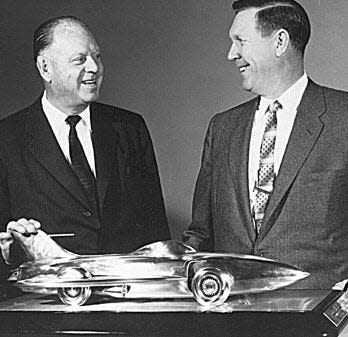
When they get to Victory Lane and get hosed down with champagne or whatever beverage they're sponsoring, the new winner of the Daytona 500 will be presented with the Harley J. Earl Trophy, a four-foot-tall, five-foot-wide black and silver creation adorned with the winners of every Daytona 500.
The trophy is named after Harley J. Earl, an automobile designer, the father of the Corvette and the second commissioner of NASCAR.
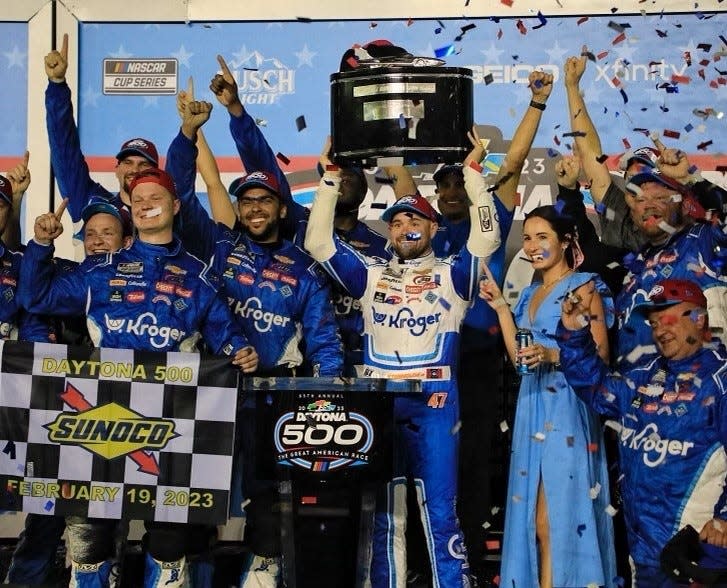
They don't get to keep it, though. After the presentation, the big trophy, also known as the Harley J. Earl Perpetual Trophy, gets put back on display at Daytona International Speedway and the winner gets a smaller replica with a black base and a scaled-down version of the Firebird One that Earl created in 1954.
The winner's car also is put on display next to the trophy for fans to see over the next year.
C. A. Bridges is a Digital Producer for the USA TODAY Network, working with multiple newsrooms across Florida. Local journalists work hard to keep you informed about the things you care about, and you can support them by subscribing to your local news organization. Read more articles by Chris here and follow him on Twitter at @cabridges
This article originally appeared on The Daytona Beach News-Journal: Daytona 500: History, definitions, qualifying, dates, time, rain

